warning PORSCHE 911 TURBO 2014 6.G User Guide
[x] Cancel search | Manufacturer: PORSCHE, Model Year: 2014, Model line: 911 TURBO, Model: PORSCHE 911 TURBO 2014 6.GPages: 300, PDF Size: 10.61 MB
Page 24 of 300
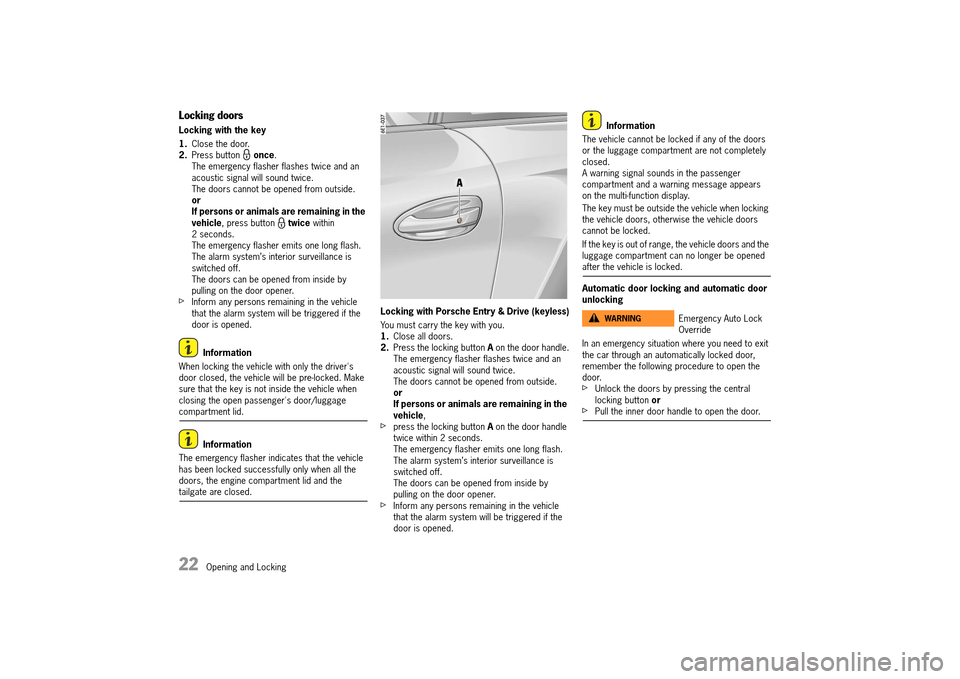
22 Opening and Locking
Locking doors
Locking with the key
1. Close the door. 2. Press button once. The emergency flasher flashes twice and an acoustic signal will sound twice.The doors cannot be opened from outside.orIf persons or animals are remaining in the vehicle , press button twice within 2 seconds.The emergency flasher emits one long flash.The alarm system’s interior surveillance is switched off.The doors can be opened from inside by pulling on the door opener.fInform any persons remaining in the vehicle that the alarm system will be triggered if the door is opened.
Information
When locking the vehicle with only the driver's door closed, the vehicle will be pre-locked. Make sure that the key is not inside the vehicle when closing the open passenger's door/luggage compartment lid.
Information
The emergency flasher indicates that the vehicle has been locked successfully only when all the doors, the engine compartment lid and the tailgate are closed.
Locking with Porsche Entry & Drive (keyless)
You must carry the key with you. 1. Close all doors. 2. Press the locking button A on the door handle. The emergency flasher flashes twice and an acoustic signal will sound twice.The doors cannot be opened from outside.orIf persons or animals are remaining in the vehicle ,fpress the locking button A on the door handle twice within 2 seconds.The emergency flasher emits one long flash.The alarm system’s interior surveillance is switched off.The doors can be opened from inside by pulling on the door opener.fInform any persons remaining in the vehicle that the alarm system will be triggered if the door is opened.
Information
The vehicle cannot be locked if any of the doors or the luggage compartment are not completely closed.A warning signal sounds in the passenger compartment and a warning message appears on the multi-function display.
The key must be outside the vehicle when locking the vehicle doors, otherwise the vehicle doors cannot be locked.
If the key is out of range, the vehicle doors and the luggage compartment can no longer be opened after the vehicle is locked.
Automatic door locking and automatic door unlocking
In an emergency situation where you need to exit the car through an automatically locked door, remember the following procedure to open the door.fUnlock the doors by pressing the central locking button or fPull the inner door handle to open the door.
Emergency Auto Lock Override
WARNINGh
14_991_Turbo_21.book Seite 22 Mittwoch, 9. April 2014 2:19 14
Page 31 of 300
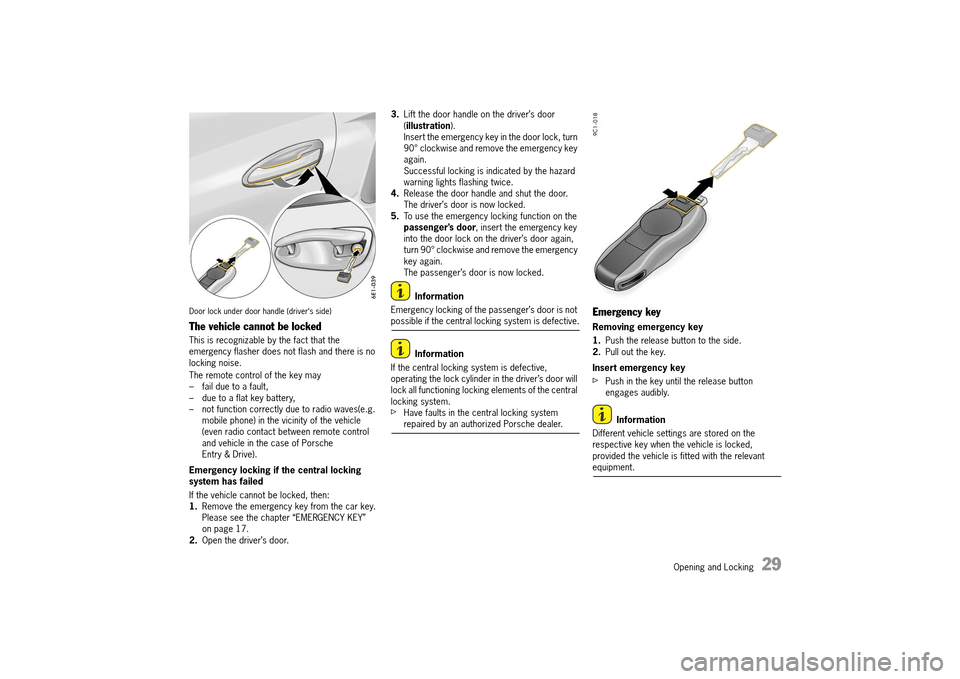
Opening and Locking 29
Door lock under door handle (driver‘s side)
The vehicle cannot be locked
This is recognizable by the fact that the emergency flasher does not flash and there is no locking noise.
The remote control of the key may – fail due to a fault,– due to a flat key battery,– not function correctly due to radio waves(e.g. mobile phone) in the vicinity of the vehicle (even radio contact between remote control and vehicle in the case of Porsche Entry & Drive).
Emergency locking if the central locking system has failed
If the vehicle cannot be locked, then: 1. Remove the emergency key from the car key. Please see the chapter “EMERGENCY KEY” on page 17.2. Open the driver’s door.
3. Lift the door handle on the driver’s door ( illustration). Insert the emergency key in the door lock, turn 90° clockwise and remove the emergency key again.Successful locking is indicated by the hazard warning lights flashing twice.4. Release the door handle and shut the door. The driver’s door is now locked.5. To use the emergency locking function on the passenger’s door , insert the emergency key into the door lock on the driver’s door again, turn 90° clockwise and remove the emergency key again.The passenger’s door is now locked.
Information
Emergency locking of the passenger’s door is not possible if the central locking system is defective.
Information
If the central locking system is defective, operating the lock cylinder in the driver’s door will lock all functioning locking elements of the central locking system.fHave faults in the central locking system repaired by an authorized Porsche dealer.
Emergency key
Removing emergency key
1. Push the release button to the side. 2. Pull out the key.
Insert emergency key
fPush in the key until the release button engages audibly.
Information
Different vehicle settings are stored on the respective key when the vehicle is locked, provided the vehicle is fitted with the relevant equipment.
14_991_Turbo_21.book Seite 29 Mittwoch, 9. April 2014 2:19 14
Page 32 of 300
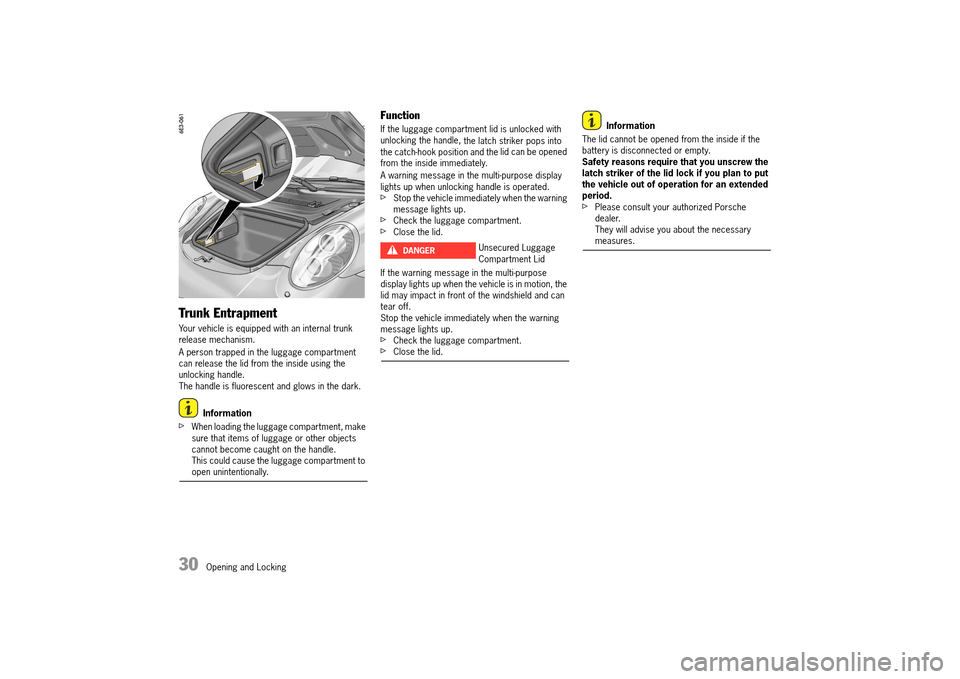
30 Opening and Locking
Trunk Entrapment
Your vehicle is equipped with an internal trunk release mechanism.
A person trapped in the luggage compartment can release the lid from the inside using the unlocking handle.The handle is fluorescent and glows in the dark.
Information
fWhen loading the luggage compartment, make sure that items of luggage or other objects cannot become caught on the handle.This could cause the luggage compartment to open unintentionally.
Function
If the luggage compartment lid is unlocked with unlocking the handle, the latch striker pops into the catch-hook position and the lid can be opened from the inside immediately.
A warning message in the multi-purpose display lights up when unlocking handle is operated.fStop the vehicle immediately when the warning message lights up.fCheck the luggage compartment.fClose the lid.
If the warning message in the multi-purpose display lights up when the vehicle is in motion, the lid may impact in front of the windshield and can tear off. Stop the vehicle immediately when the warning message lights up.fCheck the luggage compartment.fClose the lid.
Information
The lid cannot be opened from the inside if the battery is disconnected or empty.Safety reasons require that you unscrew the latch striker of the lid lock if you plan to put the vehicle out of operation for an extended period.fPlease consult your authorized Porsche dealer. They will advise you about the necessary measures.Unsecured Luggage Compartment LidDANGERh
14_991_Turbo_21.book Seite 30 Mittwoch, 9. April 2014 2:19 14
Page 34 of 300
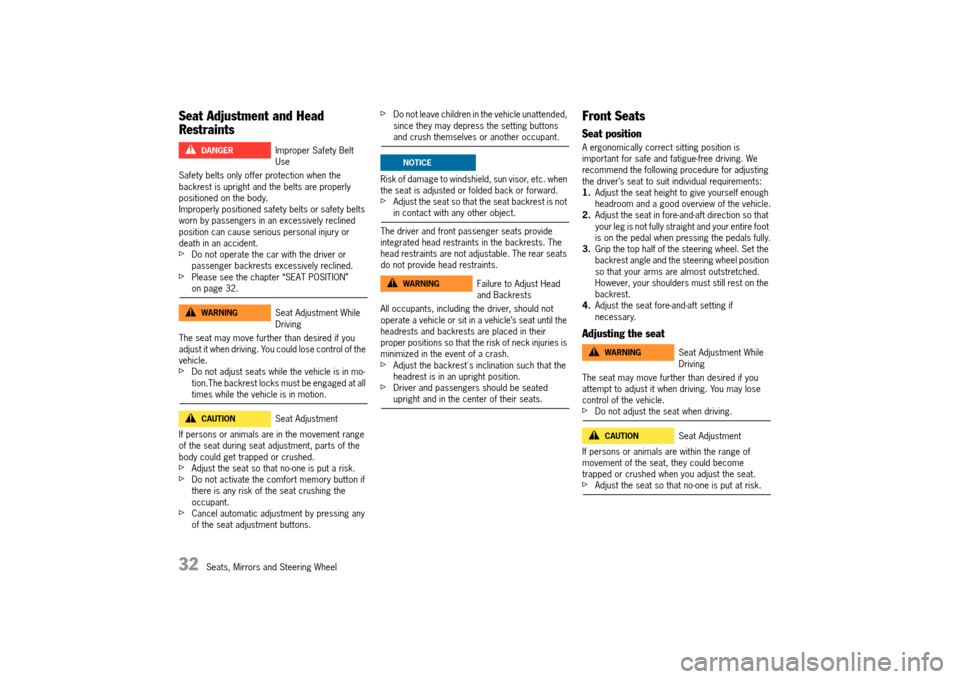
32 Seats, Mirrors and Steering Wheel
Seat Adjustment and Head
Restraints
Safety belts only offer protection when the backrest is upright and the belts are properly positioned on the body.Improperly positioned safety belts or safety belts worn by passengers in an excessively reclined position can cause serious personal injury or death in an accident.fDo not operate the car with the driver or passenger backrests excessively reclined.fPlease see the chapter “SEAT POSITION” on page 32.
The seat may move further than desired if you adjust it when driving. You could lose control of the vehicle.fDo not adjust seats while the vehicle is in mo-tion.The backrest locks must be engaged at all times while the vehicle is in motion.
If persons or animals are in the movement range of the seat during seat adjustment, parts of the body could get trapped or crushed.fAdjust the seat so that no-one is put a risk.fDo not activate the comfort memory button if there is any risk of the seat crushing the occupant.fCancel automatic adjustment by pressing any of the seat adjustment buttons.
fDo not leave children in the vehicle unattended, since they may depress the setting buttons and crush themselves or another occupant.
Risk of damage to windshield, sun visor, etc. when the seat is adjusted or folded back or forward.fAdjust the seat so that the seat backrest is not in contact with any other object.
The driver and front passenger seats provide integrated head restraints in the backrests. The head restraints are not adjustable. The rear seats do not provide head restraints.
All occupants, including the driver, should not operate a vehicle or sit in a vehicle’s seat until the headrests and backrests are placed in their proper positions so that the risk of neck injuries is minimized in the event of a crash.fAdjust the backrest's inclination such that the headrest is in an upright position.fDriver and passengers should be seated upright and in the center of their seats.
Front Seats
Seat position
A ergonomically correct sitting position is important for safe and fatigue-free driving. We recommend the following procedure for adjusting the driver’s seat to suit individual requirements: 1. Adjust the seat height to give yourself enough headroom and a good overview of the vehicle.2. Adjust the seat in fore-and-aft direction so that your leg is not fully straight and your entire foot is on the pedal when pressing the pedals fully.3. Grip the top half of the steering wheel. Set the backrest angle and the steering wheel position so that your arms are almost outstretched. However, your shoulders must still rest on the backrest.4. Adjust the seat fore-and-aft setting if necessary.
Adjusting the seat
The seat may move further than desired if you attempt to adjust it when driving. You may lose control of the vehicle.fDo not adjust the seat when driving.
If persons or animals are within the range of movement of the seat, they could become trapped or crushed when you adjust the seat.fAdjust the seat so that no-one is put at risk.
Improper Safety Belt Use
Seat Adjustment While Driving
Seat Adjustment
DANGERh
WARNINGh
CAUTIONh
Failure to Adjust Head and Backrests
NOTICE
WARNINGh
Seat Adjustment While Driving
Seat Adjustment
WARNINGh
CAUTIONh
14_991_Turbo_21.book Seite 32 Mittwoch, 9. April 2014 2:19 14
Page 39 of 300
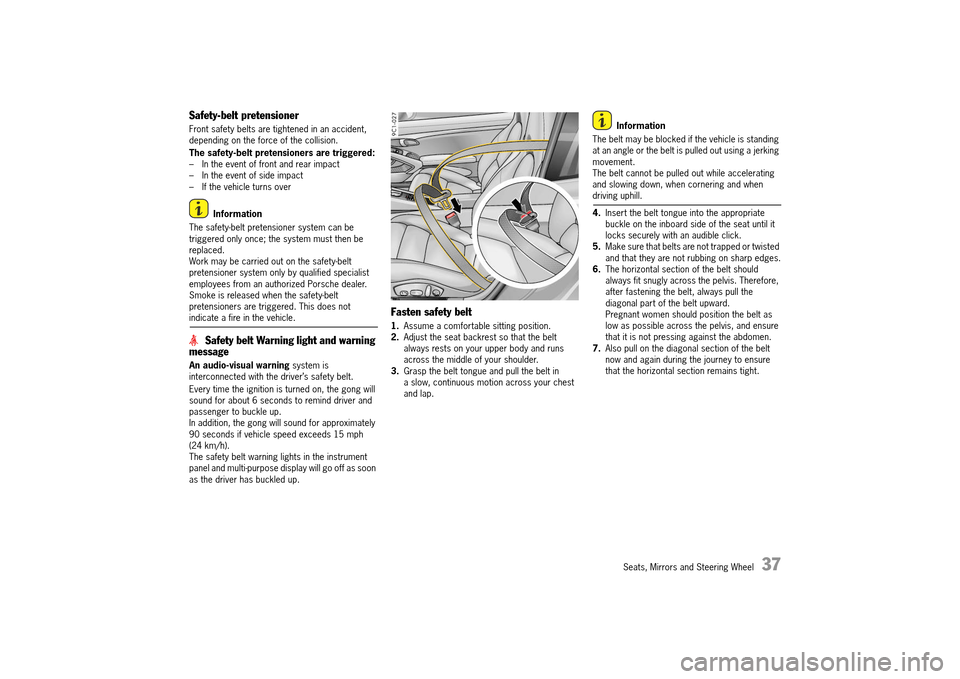
Seats, Mirrors and Steering Wheel 37
Safety-belt pretensioner
Front safety belts are tightened in an accident, depending on the force of the collision.
The safety-belt pretensioners are triggered: – In the event of front and rear impact– In the event of side impact– If the vehicle turns over
Information
The safety-belt pretensioner system can be triggered only once; the system must then be replaced. Work may be carried out on the safety-belt pretensioner system only by qualified specialist employees from an authorized Porsche dealer.Smoke is released when the safety-belt pretensioners are triggered. This does not indicate a fire in the vehicle.
Safety belt Warning light and warning message
An audio-visual warning system is interconnected with the driver’s safety belt.
Every time the ignition is turned on, the gong will sound for about 6 seconds to remind driver and passenger to buckle up.In addition, the gong will sound for approximately 90 seconds if vehicle speed exceeds 15 mph(24 km/h).The safety belt warning lights in the instrument panel and multi-purpose display will go off as soon as the driver has buckled up.
Fasten safety belt
1. Assume a comfortable sitting position. 2. Adjust the seat backrest so that the belt always rests on your upper body and runs across the middle of your shoulder.3. Grasp the belt tongue and pull the belt in a slow, continuous motion across your chest and lap.
Information
The belt may be blocked if the vehicle is standing at an angle or the belt is pulled out using a jerking movement.The belt cannot be pulled out while accelerating and slowing down, when cornering and when driving uphill.
4. Insert the belt tongue into the appropriate buckle on the inboard side of the seat until it locks securely with an audible click.5. Make sure that belts are not trapped or twisted and that they are not rubbing on sharp edges.6. The horizontal section of the belt should always fit snugly across the pelvis. Therefore, after fastening the belt, always pull the diagonal part of the belt upward.Pregnant women should position the belt as low as possible across the pelvis, and ensure that it is not pressing against the abdomen.7. Also pull on the diagonal section of the belt now and again during the journey to ensure that the horizontal section remains tight.
14_991_Turbo_21.book Seite 37 Mittwoch, 9. April 2014 2:19 14
Page 41 of 300
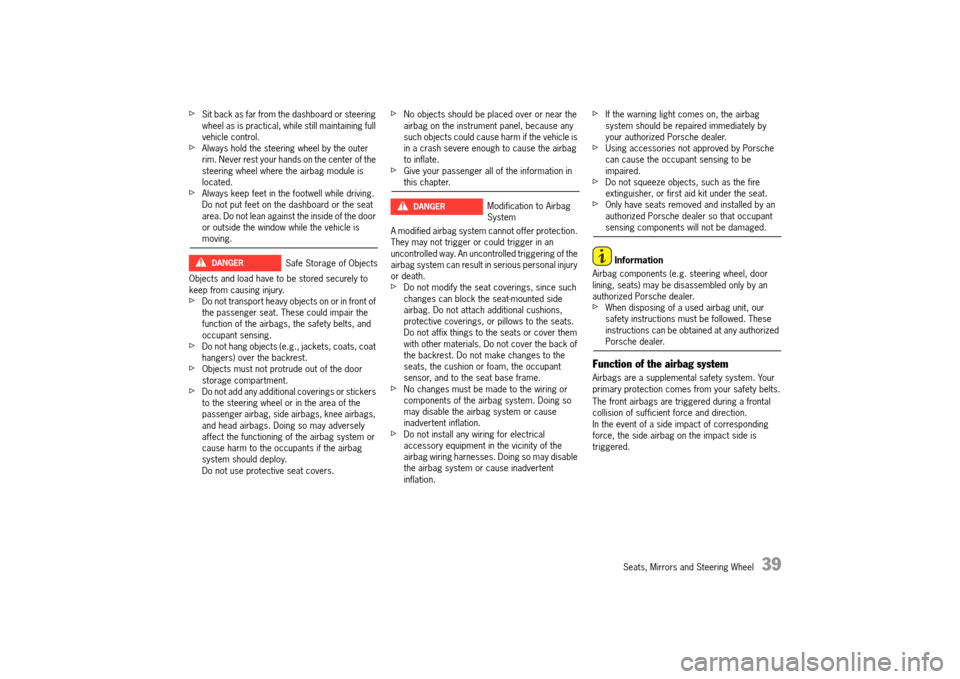
Seats, Mirrors and Steering Wheel 39
fSit back as far from the dashboard or steering wheel as is practical, while still maintaining full vehicle control.fAlways hold the steering wheel by the outer rim. Never rest your hands on the center of the steering wheel where the airbag module is located.fAlways keep feet in the footwell while driving. Do not put feet on the dashboard or the seat area. Do not lean against the inside of the door or outside the window while the vehicle is moving.
Objects and load have to be stored securely to keep from causing injury.fDo not transport heavy objects on or in front of the passenger seat. These could impair the function of the airbags, the safety belts, and occupant sensing.fDo not hang objects (e.g., jackets, coats, coat hangers) over the backrest.fObjects must not protrude out of the door storage compartment.fDo not add any additional coverings or stickers to the steering wheel or in the area of the passenger airbag, side airbags, knee airbags, and head airbags. Doing so may adversely affect the functioning of the airbag system or cause harm to the occupants if the airbag system should deploy.Do not use protective seat covers.
fNo objects should be placed over or near the airbag on the instrument panel, because any such objects could cause harm if the vehicle is in a crash severe enough to cause the airbag to inflate.fGive your passenger all of the information in this chapter.
A modified airbag system cannot offer protection. They may not trigger or could trigger in an uncontrolled way. An uncontrolled triggering of the airbag system can result in serious personal injury or death.fDo not modify the seat coverings, since such changes can block the seat-mounted side airbag. Do not attach additional cushions, protective coverings, or pillows to the seats. Do not affix things to the seats or cover them with other materials. Do not cover the back of the backrest. Do not make changes to the seats, the cushion or foam, the occupant sensor, and to the seat base frame.fNo changes must be made to the wiring or components of the airbag system. Doing so may disable the airbag system or cause inadvertent inflation.fDo not install any wiring for electrical accessory equipment in the vicinity of the airbag wiring harnesses. Doing so may disable the airbag system or cause inadvertent inflation.
fIf the warning light comes on, the airbag system should be repaired immediately by your authorized Porsche dealer.fUsing accessories not approved by Porsche can cause the occupant sensing to be impaired.fDo not squeeze objects, such as the fire extinguisher, or first aid kit under the seat.fOnly have seats removed and installed by an authorized Porsche dealer so that occupant sensing components will not be damaged.
Information
Airbag components (e.g. steering wheel, door lining, seats) may be disassembled only by an authorized Porsche dealer.fWhen disposing of a used airbag unit, our safety instructions must be followed. These instructions can be obtained at any authorized Porsche dealer.
Function of the airbag system
Airbags are a supplemental safety system. Your primary protection comes from your safety belts.
The front airbags are triggered during a frontal collision of sufficient force and direction.In the event of a side impact of corresponding force, the side airbag on the impact side is triggered.
Safe Storage of ObjectsDANGERh
Modification to Airbag SystemDANGERh
14_991_Turbo_21.book Seite 39 Mittwoch, 9. April 2014 2:19 14
Page 42 of 300
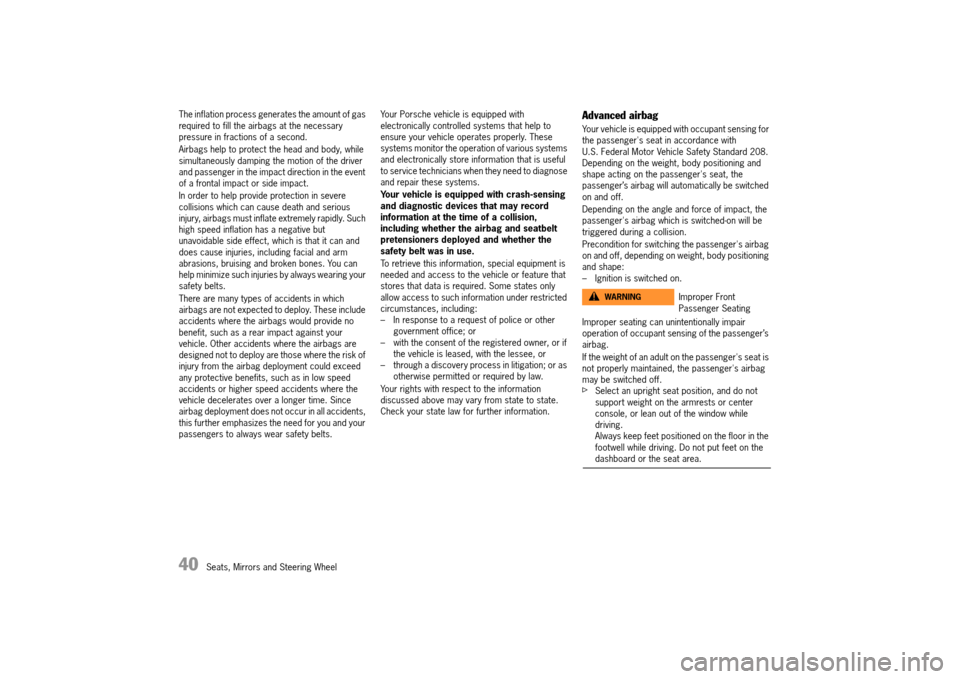
40 Seats, Mirrors and Steering Wheel
The inflation process generates the amount of gas required to fill the airbags at the necessary pressure in fractions of a second.
Airbags help to protect the head and body, while simultaneously damping the motion of the driver and passenger in the impact direction in the event of a frontal impact or side impact.
In order to help provide protection in severe collisions which can cause death and serious injury, airbags must inflate extremely rapidly. Such high speed inflation has a negative but unavoidable side effect, which is that it can and does cause injuries, including facial and arm abrasions, bruising and broken bones. You can help minimize such injuries by always wearing your safety belts.
There are many types of accidents in which airbags are not expected to deploy. These include accidents where the airbags would provide no benefit, such as a rear impact against your vehicle. Other accidents where the airbags are designed not to deploy are those where the risk of injury from the airbag deployment could exceed any protective benefits, such as in low speed accidents or higher speed accidents where the vehicle decelerates over a longer time. Since airbag deployment does not occur in all accidents, this further emphasizes the need for you and your passengers to always wear safety belts.
Your Porsche vehicle is equipped with electronically controlled systems that help to ensure your vehicle operates properly. These systems monitor the operation of various systems and electronically store information that is useful to service technicians when they need to diagnose and repair these systems.
Your vehicle is equipped with crash-sensing and diagnostic devices that may record information at the time of a collision, including whether the airbag and seatbelt pretensioners deployed and whether the safety belt was in use.
To retrieve this information, special equipment is needed and access to the vehicle or feature that stores that data is required. Some states only allow access to such information under restricted circumstances, including: – In response to a request of police or other government office; or – with the consent of the registered owner, or if the vehicle is leased, with the lessee, or – through a discovery process in litigation; or as otherwise permitted or required by law.
Your rights with respect to the information discussed above may vary from state to state. Check your state law for further information.
Advanced airbag
Your vehicle is equipped with occupant sensing for the passenger's seat in accordance with U.S. Federal Motor Vehicle Safety Standard 208. Depending on the weight, body positioning and shape acting on the passenger's seat, the passenger’s airbag will automatically be switched on and off.
Depending on the angle and force of impact, the passenger's airbag which is switched-on will be triggered during a collision.
Precondition for switching the passenger's airbag on and off, depending on weight, body positioning and shape:– Ignition is switched on.
Improper seating can unintentionally impair operation of occupant sensing of the passenger’s airbag.
If the weight of an adult on the passenger's seat is not properly maintained, the passenger's airbag may be switched off.fSelect an upright seat position, and do not support weight on the armrests or center console, or lean out of the window while driving. Always keep feet positioned on the floor in the footwell while driving. Do not put feet on the dashboard or the seat area.
Improper Front Passenger Seating
WARNINGh
14_991_Turbo_21.book Seite 40 Mittwoch, 9. April 2014 2:19 14
Page 43 of 300
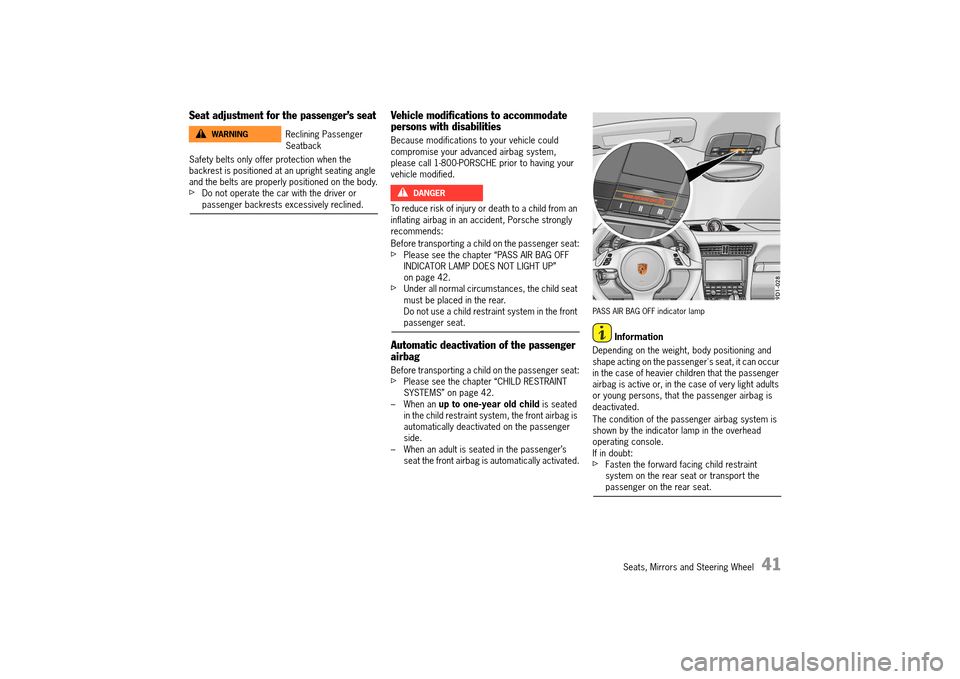
Seats, Mirrors and Steering Wheel 41
Seat adjustment for the passenger’s seat
Safety belts only offer protection when the backrest is positioned at an upright seating angle and the belts are properly positioned on the body.fDo not operate the car with the driver or passenger backrests excessively reclined.
Vehicle modifications to accommodate persons with disabilities
Because modifications to your vehicle could compromise your advanced airbag system, please call 1-800-PORSCHE prior to having your vehicle modified.
To reduce risk of injury or death to a child from an inflating airbag in an accident, Porsche strongly recommends:
Before transporting a child on the passenger seat:fPlease see the chapter “PASS AIR BAG OFF INDICATOR LAMP DOES NOT LIGHT UP” on page 42.fUnder all normal circumstances, the child seat must be placed in the rear. Do not use a child restraint system in the front passenger seat.
Automatic deactivation of the passenger airbag
Before transporting a child on the passenger seat:fPlease see the chapter “CHILD RESTRAINT SYSTEMS” on page 42.– When an up to one-year old child is seated in the child restraint system, the front airbag is automatically deactivated on the passenger side.– When an adult is seated in the passenger’s seat the front airbag is automatically activated.
PASS AIR BAG OFF indicator lamp
Information
Depending on the weight, body positioning and shape acting on the passenger's seat, it can occur in the case of heavier children that the passenger airbag is active or, in the case of very light adults or young persons, that the passenger airbag is deactivated.
The condition of the passenger airbag system is shown by the indicator lamp in the overhead operating console.If in doubt:fFasten the forward facing child restraint system on the rear seat or transport the passenger on the rear seat.
Reclining Passenger Seatback
WARNINGh
DANGERh
14_991_Turbo_21.book Seite 41 Mittwoch, 9. April 2014 2:19 14
Page 44 of 300
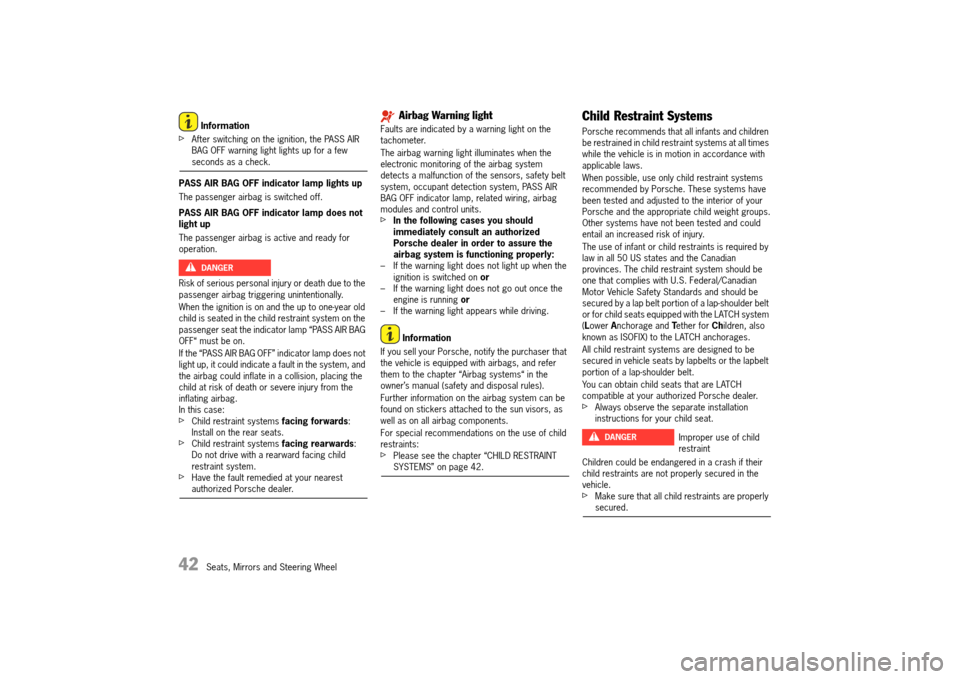
42 Seats, Mirrors and Steering Wheel
Information
fAfter switching on the ignition, the PASS AIR BAG OFF warning light lights up for a few seconds as a check.
PASS AIR BAG OFF indicator lamp lights up
The passenger airbag is switched off.
PASS AIR BAG OFF indicator lamp does not light up
The passenger airbag is active and ready for operation.
Risk of serious personal injury or death due to the passenger airbag triggering unintentionally.
When the ignition is on and the up to one-year old child is seated in the child restraint system on the passenger seat the indicator lamp “PASS AIR BAG OFF“ must be on.
If the “PASS AIR BAG OFF” indicator lamp does not light up, it could indicate a fault in the system, and the airbag could inflate in a collision, placing the child at risk of death or severe injury from the inflating airbag.In this case:fChild restraint systems facing forwards: Install on the rear seats.fChild restraint systems facing rearwards: Do not drive with a rearward facing child restraint system.fHave the fault remedied at your nearest authorized Porsche dealer.
Airbag Warning light
Faults are indicated by a warning light on the tachometer.
The airbag warning light illuminates when the electronic monitoring of the airbag system detects a malfunction of the sensors, safety belt system, occupant detection system, PASS AIR BAG OFF indicator lamp, related wiring, airbag modules and control units.fIn the following cases you should immediately consult an authorized Porsche dealer in order to assure the airbag system is functioning properly: – If the warning light does not light up when the ignition is switched on or – If the warning light does not go out once the engine is running or – If the warning light appears while driving.
Information
If you sell your Porsche, notify the purchaser that the vehicle is equipped with airbags, and refer them to the chapter “Airbag systems“ in the owner’s manual (safety and disposal rules).
Further information on the airbag system can be found on stickers attached to the sun visors, as well as on all airbag components.
For special recommendations on the use of child restraints:fPlease see the chapter “CHILD RESTRAINT SYSTEMS” on page 42.
Child Restraint Systems
Porsche recommends that all infants and children be restrained in child restraint systems at all times while the vehicle is in motion in accordance with applicable laws.
When possible, use only child restraint systems recommended by Porsche. These systems have been tested and adjusted to the interior of your Porsche and the appropriate child weight groups.Other systems have not been tested and could entail an increased risk of injury.
The use of infant or child restraints is required by law in all 50 US states and the Canadian provinces. The child restraint system should be one that complies with U.S. Federal/Canadian Motor Vehicle Safety Standards and should be secured by a lap belt portion of a lap-shoulder belt or for child seats equipped with the LATCH system ( Lower Anchorage and Tether for Children, also known as ISOFIX) to the LATCH anchorages.
All child restraint systems are designed to be secured in vehicle seats by lapbelts or the lapbelt portion of a lap-shoulder belt.
You can obtain child seats that are LATCH compatible at your authorized Porsche dealer.fAlways observe the separate installation instructions for your child seat.
Children could be endangered in a crash if their child restraints are not properly secured in the vehicle.fMake sure that all child restraints are properly secured.
DANGERh
Improper use of child restraint
DANGERh
14_991_Turbo_21.book Seite 42 Mittwoch, 9. April 2014 2:19 14
Page 45 of 300
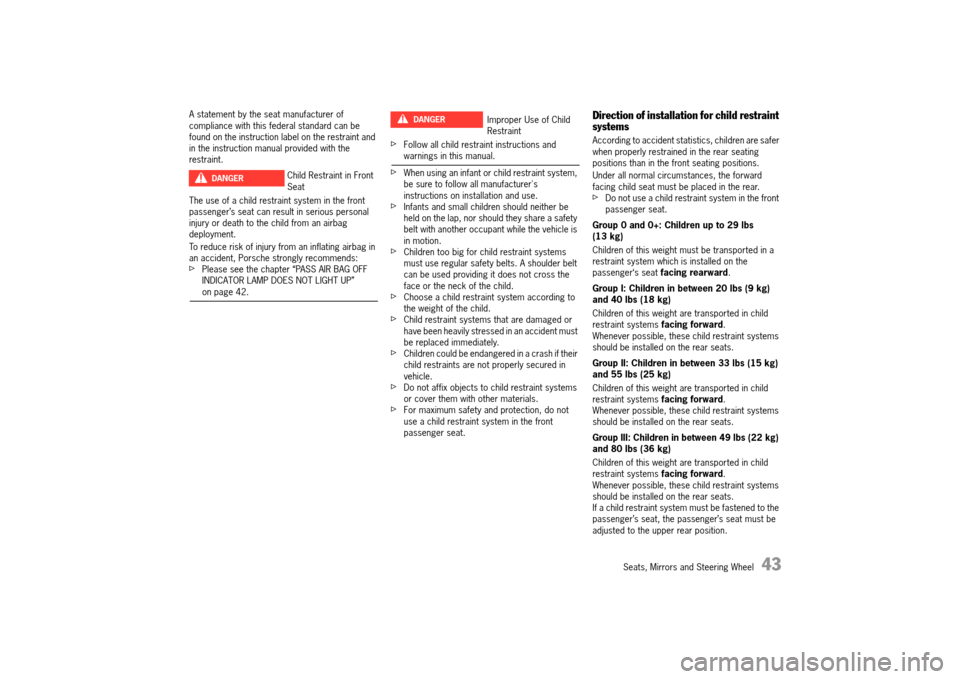
Seats, Mirrors and Steering Wheel 43
A statement by the seat manufacturer of compliance with this federal standard can be found on the instruction label on the restraint and in the instruction manual provided with the restraint.
The use of a child restraint system in the front passenger’s seat can result in serious personal injury or death to the child from an airbag deployment.
To reduce risk of injury from an inflating airbag in an accident, Porsche strongly recommends:fPlease see the chapter “PASS AIR BAG OFF INDICATOR LAMP DOES NOT LIGHT UP” on page 42.
fFollow all child restraint instructions and warnings in this manual.
fWhen using an infant or child restraint system, be sure to follow all manufacturer's instructions on installation and use.fInfants and small children should neither be held on the lap, nor should they share a safety belt with another occupant while the vehicle is in motion.fChildren too big for child restraint systems must use regular safety belts. A shoulder belt can be used providing it does not cross the face or the neck of the child.fChoose a child restraint system according to the weight of the child.fChild restraint systems that are damaged or have been heavily stressed in an accident must be replaced immediately.fChildren could be endangered in a crash if their child restraints are not properly secured in vehicle.fDo not affix objects to child restraint systems or cover them with other materials.fFor maximum safety and protection, do not use a child restraint system in the front passenger seat.
Direction of installation for child restraint systems
According to accident statistics, children are safer when properly restrained in the rear seating positions than in the front seating positions.
Under all normal circumstances, the forward facing child seat must be placed in the rear. fDo not use a child restraint system in the front passenger seat.
Group 0 and 0+: Children up to 29 lbs (13 kg)
Children of this weight must be transported in a restraint system which is installed on the passenger‘s seat facing rearward.
Group I: Children in between 20 lbs (9 kg) and 40 lbs (18 kg)
Children of this weight are transported in child restraint systems facing forward. Whenever possible, these child restraint systems should be installed on the rear seats.
Group II: Children in between 33 lbs (15 kg) and 55 lbs (25 kg)
Children of this weight are transported in child restraint systems facing forward. Whenever possible, these child restraint systems should be installed on the rear seats.
Group III: Children in between 49 lbs (22 kg) and 80 lbs (36 kg)
Children of this weight are transported in child restraint systems facing forward. Whenever possible, these child restraint systems should be installed on the rear seats.If a child restraint system must be fastened to the passenger’s seat, the passenger’s seat must be adjusted to the upper rear position.
Child Restraint in Front SeatDANGER h
Improper Use of Child Restraint
DANGERh
14_991_Turbo_21.book Seite 43 Mittwoch, 9. April 2014 2:19 14